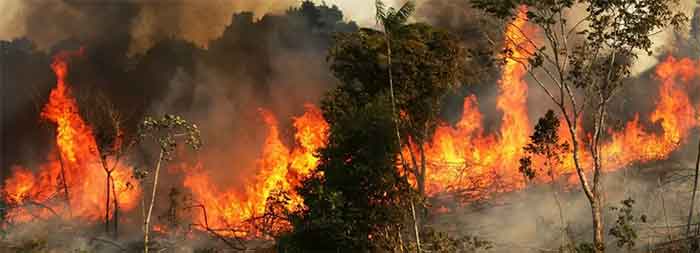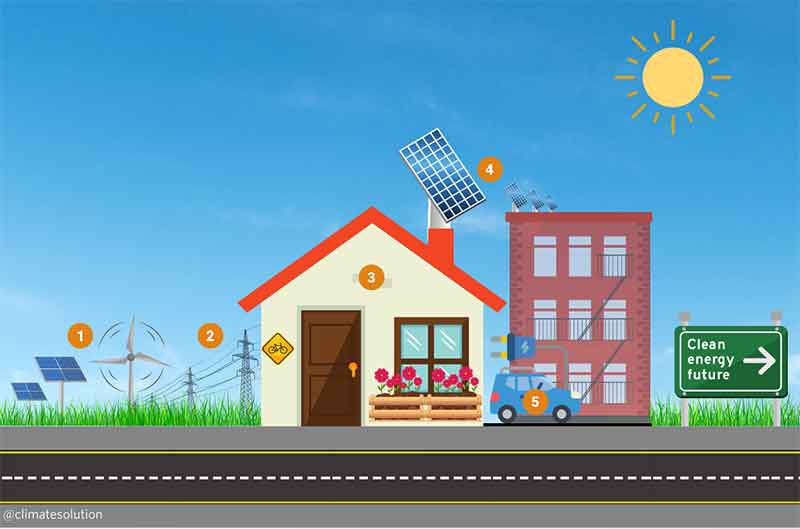Experts weigh in on how to change the systems and behaviors leading us to catastrophe.

One of the best-known features of the Amazon rainforest is that it is, well, wet. But increasingly researchers are wondering how much longer that will be true. About three decades ago, disquieting research began suggesting that the twin effects of deforestation and climate change could cause the South American forest to tip. The forest would shift from lush, wet, and dense to a drier, more savanna-like landscape.
It’s a transformation that’s more than aesthetic.
For roughly two centuries, the Amazon has acted as a buffer, protecting us from some of the worst effects of carbon dioxide pollution. In a good year, it absorbs up to 2 billion tons of climate warming emissions a year. But over the past few decades, it’s had fewer good years. Deforestation, to clear the Amazon to grow soybeans for cattle feed or for animal pasture, has made drought in the region worse, and the drying wetlands release nitrous oxide, a greenhouse gas. The burning that often accompanies land clearing also releases greenhouse gas emissions while also creating black carbon, a soot-like product that attracts heat, warming things up even more. As the Amazon moves from rainforest to savanna, a process researchers call savanafication, instead of absorbing climate pollution it will release it. The Amazon would begin to heat up the planet. In fact, a recent study in the journal Nature found that the heavily deforested eastern part of Amazonia has already tipped. It now emits more carbon than it absorbs.
The Amazon is not the only system that can tip, creating a reinforcing cycle that makes climate change even worse.
“In the climate, or bits of the climate system, sometimes just a little bit of extra warming can cause abrupt and/or irreversible change,” said Tim Lenton, the director of the Global Systems Institute at the University of Exeter who has been sounding the alarm on climate tipping points since 2008.
His 2019 comment published in Nature noted, for example, that should a part of a West Antarctic ice sheet collapse it might bring the rest of the ice sheet with it. The ice sheet would topple like dominoes, eventually causing sea level to rise by close to 10 feet.
Similarly, new analysis suggests that the Atlantic Meridional Overturning Circulation, the ocean system made famous by its exaggerated role in the blockbuster film The Day After Tomorrow, may be closer to collapse than earlier studies have suggested—as early as next century rather than 300 years down the line. The circulation is a system of ocean currents that brings warm water from the tropics to the northern Atlantic and sends cold water back to the tropics. The process helps to distribute heat and energy across the planet contributing to the climate we’ve become accustomed to. Its collapse would upend, among other things, the West African monsoon, a seasonal rainfall critical to the West Africa’s farmers.
It does so by shifting the way ocean currents move such that the Gulf of Guinea, which borders countries including Nigeria, Cameroon, and Benin, warms up. “In some of the models the Gulf of Guinea will suddenly warm up like three degrees,” said Lenton. “Now that is a big problem for the monsoon because the monsoon relies on the land heating up more than the ocean. And that’s why it kind of breaks the monsoon.”
Given the potentially catastrophic impacts of climate tipping points, it might seem surprising that the report released by the United Nations Intergovernmental Panel on Climate Change makes only a handful of references to tipping points. The report, created by a global panel of scientists, is the first of four to be released between now and early 2022 and is focused on the physical science underpinning climate change. The choice to limit the use of tipping points was intentional, according to Bob Kopp, director of the Rutgers University Institute of Earth, Ocean & Atmospheric Sciences and author of the report’s Summary for Policymakers. And it goes back to the ways in which Lenton described what a tipping point is—a change that could be very fast, or irreversible…or both.
“Because there’s so much bundled into this concept, we try to focus more on specific defined elements like abrupt change, or irreversibility, and less on this sort of really bundle of things that are called tipping points,” said Kopp.
Maisa Rojas Corradi, the director for the Center for Climate and Resilience Research at the University of Chile and coordinating lead author on chapter I of the IPCC 6th Assessment Report, added that even though you won’t find the phrase “tipping point” frequently in the document, the emphasis on these kinds of lower likelihood but high-impact outcomes are in the report nestled in the risk assessment section.
As for Lenton, he says there’s another kind of tipping point that people should consider. Our fate, to borrow from the movie The Terminator, is what we make. There’s a certain amount of warming that is now locked in because of the nature of the climate system: it’s like trying to halt a large vehicle. But how much worse things will get—that is up to us.
So how do we change the systems and the behaviors that are leading us to catastrophe? Lenton looks into this with co-author Simon Sharpe in a recent paper that contains a somewhat unusual phrase for a climate study: “plausible grounds for hope.”
“I’m basically saying, look, we’ve got plenty of evidence that tipping point-type changes happen in human society and in their relationship with technology as well as with ecology, and have done so in the past,” said Lenton. “For good, or ill, we’ve had this rapid transition from horse drawn carriages to motorcars in the 1900s in the US, for example. We know that there are these reinforcing feedbacks in societies. And we know that we need to accelerate action on climate change by about a factor of five, give or take. So how on earth are we going to do that? Only if we can find and trigger some really strong reinforcing feedbacks, and hopefully, they’re so strong, they’re almost like these tipping point dynamics where a little nudge can certainly tip the rest of the population to change.”
We see the kind of behavior that Lenton is referring to on a much smaller scale when fashion styles change and suddenly everyone is wearing the same style of jeans, or when certain words, such as racial slurs, or behaviors, like sexual harassment, that were once normal become taboo. We also see this in the climate space. The report points to the way the UK transitioned to an energy sector that is now 43% renewable first by subsidizing investments in renewable energy, which led to renewable energy eventually becoming cheaper—even without subsidies—than coal. And these tipping points aren’t limited just to technologies, but also to social movements, like Fridays For Future, the climate movement begun by Greta Thunberg, or the Sunrise Movement, which helped propel forward the Green New Deal and make climate a subject presidential candidates had to address in this most recent election.
“Friday’s For Future and the other new, largely youth-led climate movements are a classic example of just social tipping dynamics that have been described since the 1980s,” said Lenton.
After the IPCC report was released, Friday’s for Future tweeted, “With the latest #IPCC Climate Report, we must remember our power. Every fraction of a degree matters and we must fight harder than ever. Join the movement.#UprootTheSystem.”
Kendra Pierre-Louis is a climate reporter and contributing writer to Sierra. She currently works for Gimlet, the podcasting company, and co-host of How to Save a Planet. Previously she was a climate reporter with The New York Times, a staff writer for Popular Science (PopSci) where she wrote about science, the environment, and, occasionally, mayonnaise. In addition, her writing has appeared in FiveThirtyEight, The Washington Post, Newsweek, Modern Farmer, and Slate. Kendra is also the author of the book, Green Washed: Why We Can’t Buy Our Way to a Green Planet.
















































